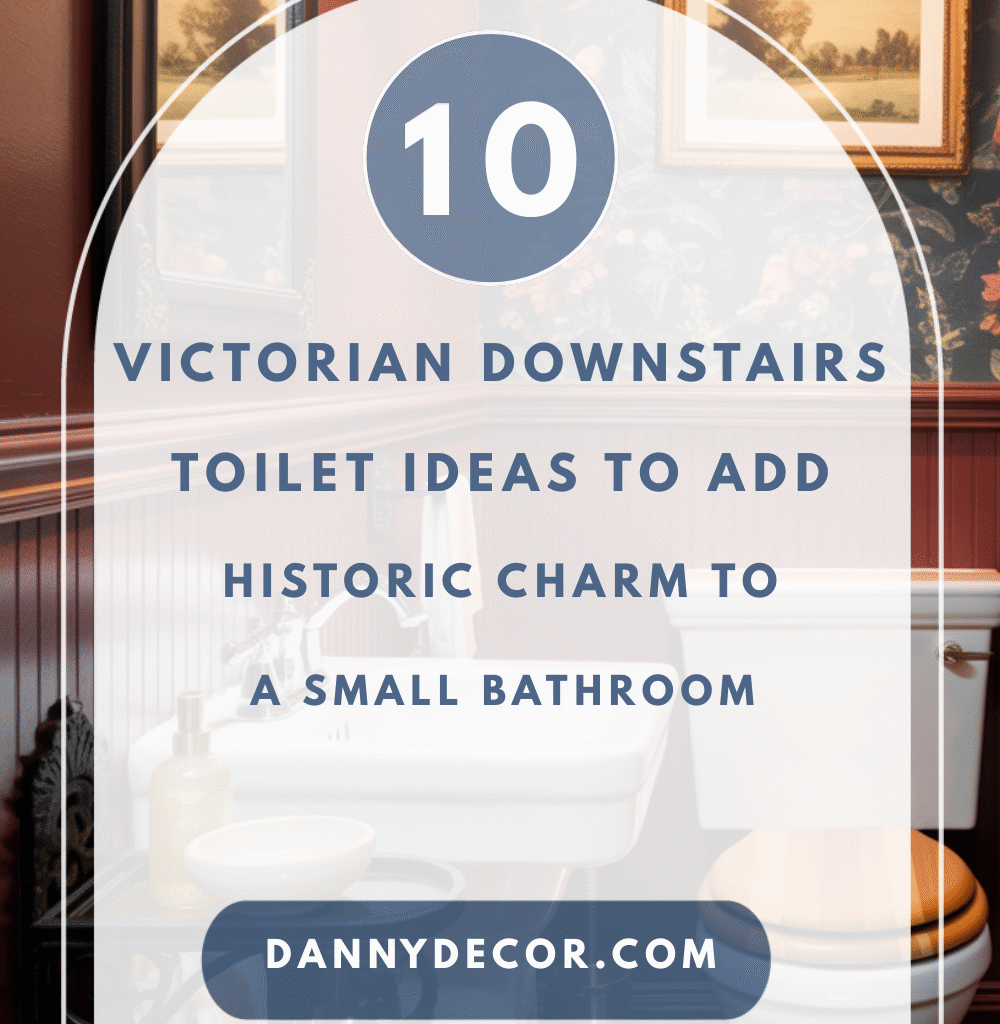
The downstairs toilet – often dismissed as a mere afterthought in home design – actually presents one of the most exciting opportunities to create something truly special. In my twenty years of helping homeowners reimagine their spaces, I’ve discovered that these compact rooms offer the perfect canvas for bold Victorian drama without the commitment required for larger spaces.
There’s something wonderfully liberating about designing a small powder room. Your guests will spend just a few minutes inside, but those minutes can be absolutely transformative when they’re surrounded by rich wallpapers, gleaming brass fixtures, and the kind of ornate detailing that makes you feel like you’ve stepped back in time. The Victorian era, with its unabashed love of pattern, texture, and decorative excess, is perfectly suited to these intimate spaces where every surface can tell a story.
What fascinates me most about Victorian design is how it embraces the idea that even the most utilitarian spaces deserve beauty. The Victorians understood that daily rituals – including the most private ones – should be elevated by thoughtful design. They created spaces that were both functional and theatrical, practical yet deeply atmospheric.
The key to successful Victorian toilet design lies in understanding that authenticity doesn’t mean sacrificing modern comfort. Instead, it’s about capturing the essence of Victorian sensibility – the rich colors, the attention to detail, the sense of craftsmanship – while ensuring your space works beautifully for contemporary life. Let me share ten ideas that will help you create a downstairs toilet that transports your guests while serving your practical needs perfectly.
10 Victorian-Inspired Downstairs Toilet Ideas
1. Create Drama with Richly Patterned Wallpaper
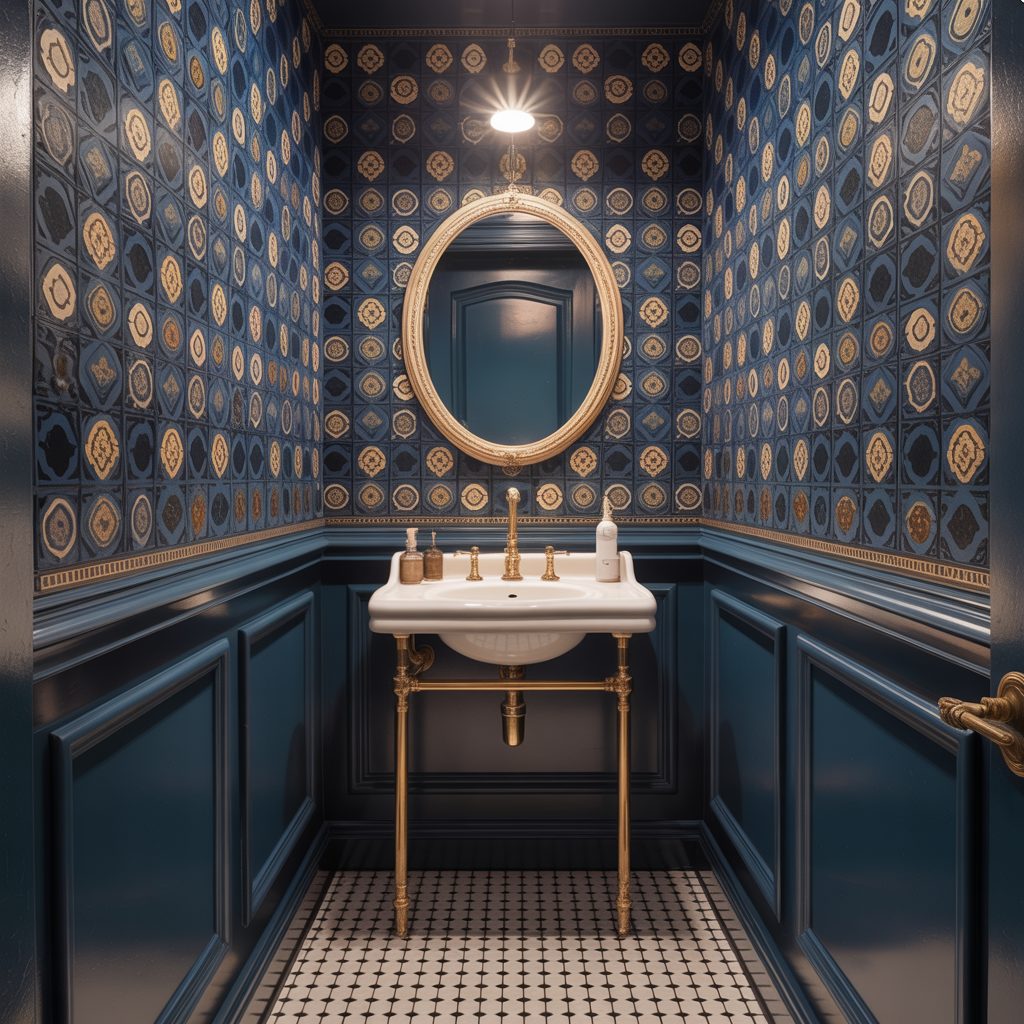
Nothing says Victorian quite like wallpaper that makes a statement, and the downstairs toilet is the perfect place to embrace patterns that might feel overwhelming in larger spaces. Think beyond simple florals Victorian wallpaper was often an explosion of botanical motifs, geometric patterns, and rich, saturated colours that created rooms with genuine personality and drama.
The beauty of using bold wallpaper in a small space is that it creates an immersive experience. Your guests step into what feels like a jewel box, surrounded by pattern and colour that engages the eye and creates visual interest from floor to ceiling. Deep burgundy papers with gold accents, forest green designs with intricate botanical details, or navy backgrounds with ornate geometric patterns can transform a simple toilet into a space that feels both luxurious and historically authentic.
When selecting Victorian-inspired wallpaper, consider the scale of your space. Smaller patterns can make a tiny room feel busy, while appropriately scaled larger patterns create depth and sophistication. The goal is to create a sense of enveloping richness rather than visual chaos. Remember that in Victorian times, wallpaper was often the room’s primary decorative element, so choose something that can carry the entire design scheme.
2. Install Traditional Brass Fixtures for Authentic Elegance
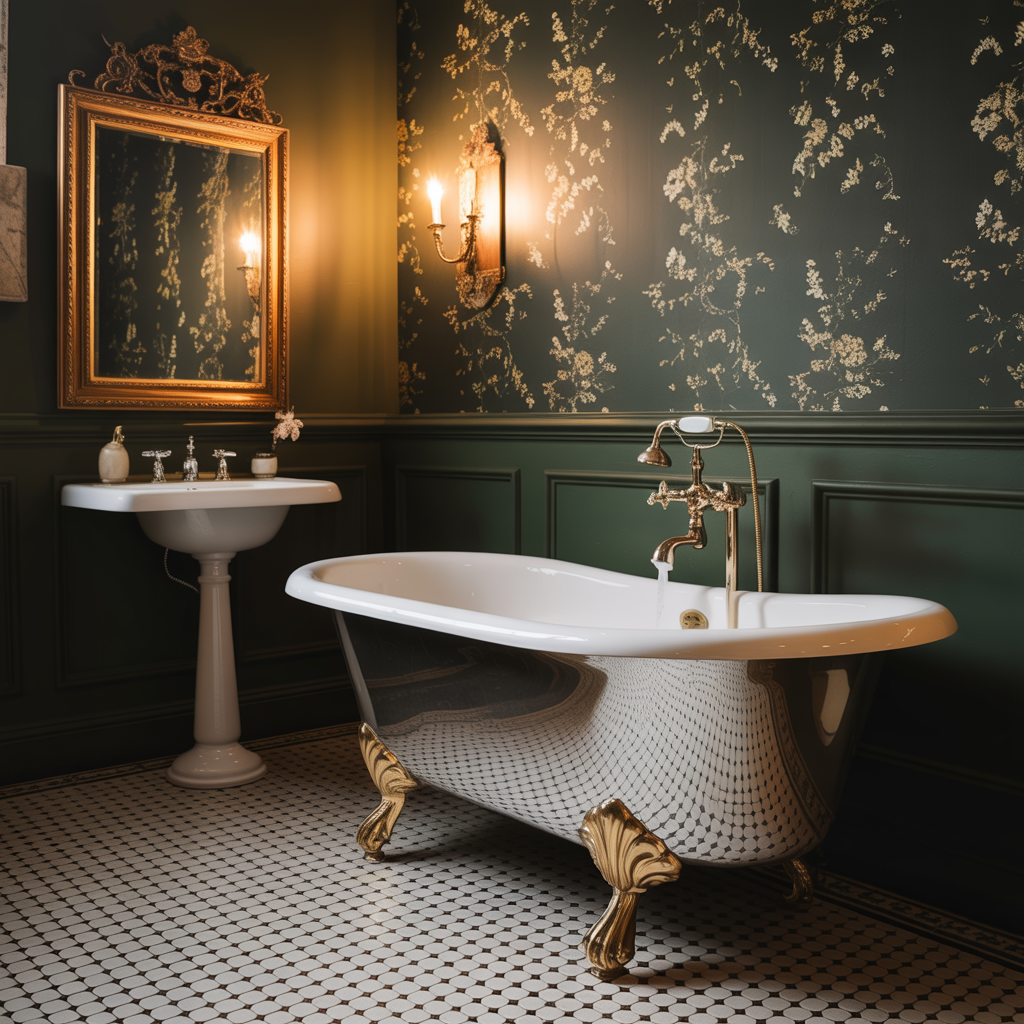
Brass fixtures are the jewellery of Victorian bathroom design they catch the light, add warmth, and provide the kind of craftsmanship details that immediately signal quality and attention to historical accuracy. The key is choosing pieces that feel substantial and well-made, with the kind of weight and finish that suggests they’ll last for generations.
Traditional brass taps with ceramic handles, ornate towel rails, and decorative hooks create a cohesive metallic theme that ties the entire space together. The warm golden tones of brass complement the rich colours typically associated with Victorian design, creating a harmonious palette that feels both elegant and inviting. Unlike modern chrome or stainless steel, brass develops a patina over time that adds to its character and authenticity.
What makes brass particularly perfect for Victorian-inspired spaces is its versatility. Whether you choose highly polished brass for maximum glamour or slightly aged brass for a more lived-in feel, these fixtures provide the kind of decorative details that Victorians loved. They’re functional art pieces that serve daily needs while contributing to the overall aesthetic story of your space.
3. Embrace Deep Heritage Colors for Sophisticated Ambiance
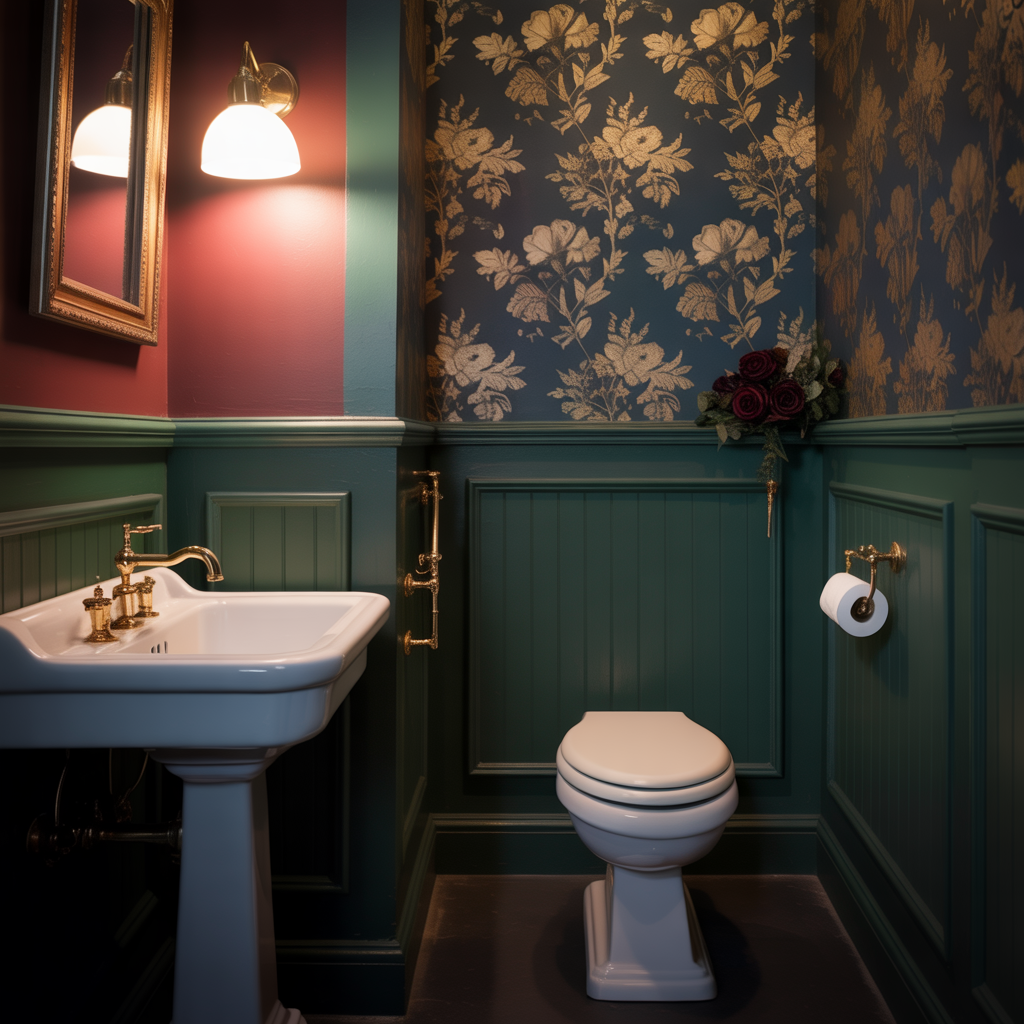
Victorian colour palettes were anything but timid. These were people who embraced deep, saturated colors that created mood and atmosphere forest greens, rich burgundies, deep navy blues, and warm plums that made rooms feel cocooned and intimate. In a downstairs toilet, these colors create exactly the kind of sophisticated ambiance that makes guests feel they’ve discovered something special.
The psychology of color in small spaces is fascinating. While conventional wisdom might suggest using light colors to make a room feel larger, Victorian design proves that dark, rich colors can actually make a space feel more luxurious and intentional. A deep green or burgundy creates a sense of enclosure that feels protective rather than claustrophobic, especially when balanced with good lighting and metallic accents.
Consider using these heritage colours strategically perhaps as wainscoting below a decorative chair rail, or as an accent wall behind your toilet. The key is creating depth and visual interest while maintaining the sophisticated restraint that characterizes the best Victorian design. These colours work particularly well with white or cream sanitary ware, creating the kind of high-contrast combinations that Victorians loved.
4. Add Architectural Character with Decorative Wainscoting
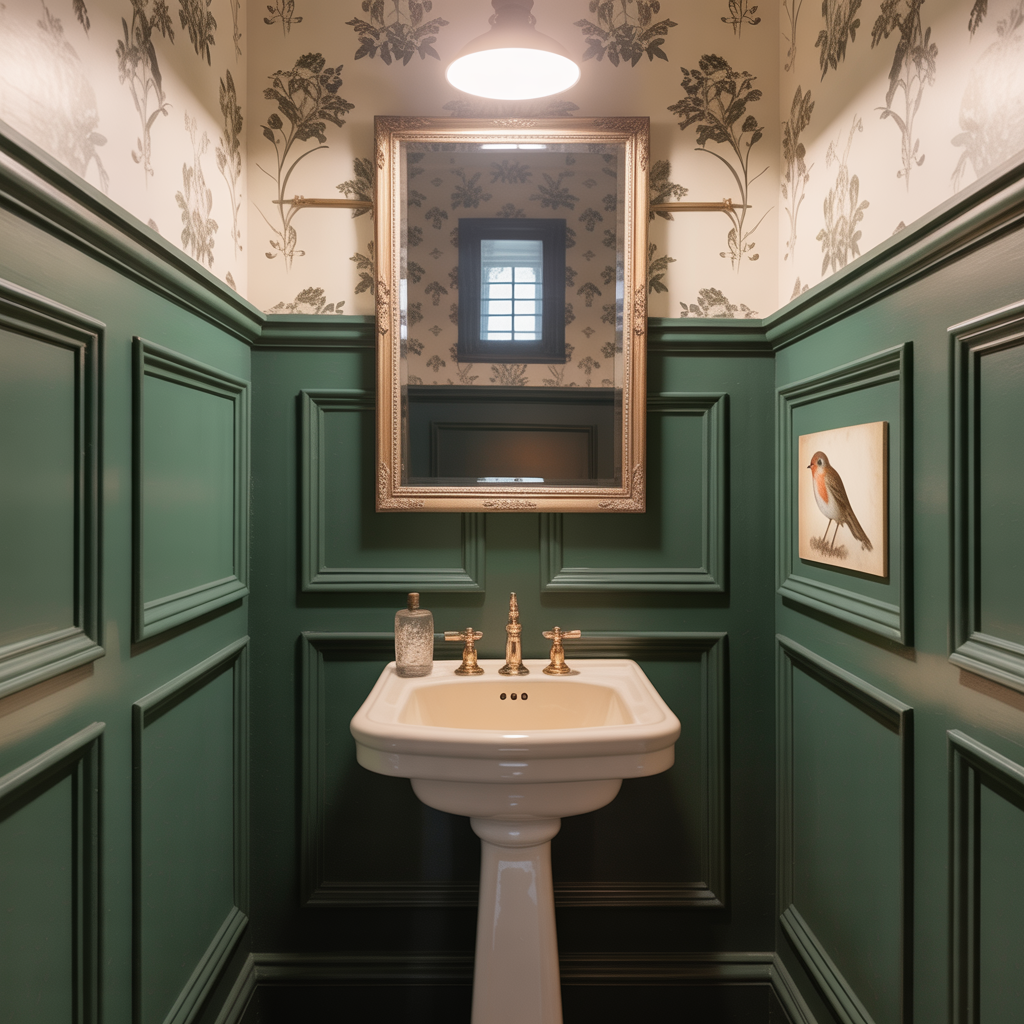
Wainscoting serves both practical and aesthetic purposes in Victorian design, and it’s particularly effective in downstairs toilets where it can add architectural interest while protecting walls from daily wear. Traditional Victorian wainscoting typically extends to about chair rail height, creating a visual break that adds proportion and sophistication to small spaces.
The beauty of wainscoting in a toilet is how it creates the illusion of height and grandeur even in compact dimensions. When painted in deep heritage colors and topped with decorative chair rail molding, wainscoting transforms plain walls into architectural features that suggest the kind of craftsmanship and attention to detail that characterizes Victorian design.
Consider the profile and style of your wainscoting carefully. Raised panel wainscoting creates more visual interest and shadow lines than simple flat panels, while breadboard wainscoting offers a more cottage-like Victorian feel. The key is choosing a style that complements your home’s existing architecture while adding the kind of period-appropriate detailing that makes your downstairs toilet feel like an integral part of a Victorian home.
5. Choose Period-Appropriate Lighting for Authentic Atmosphere
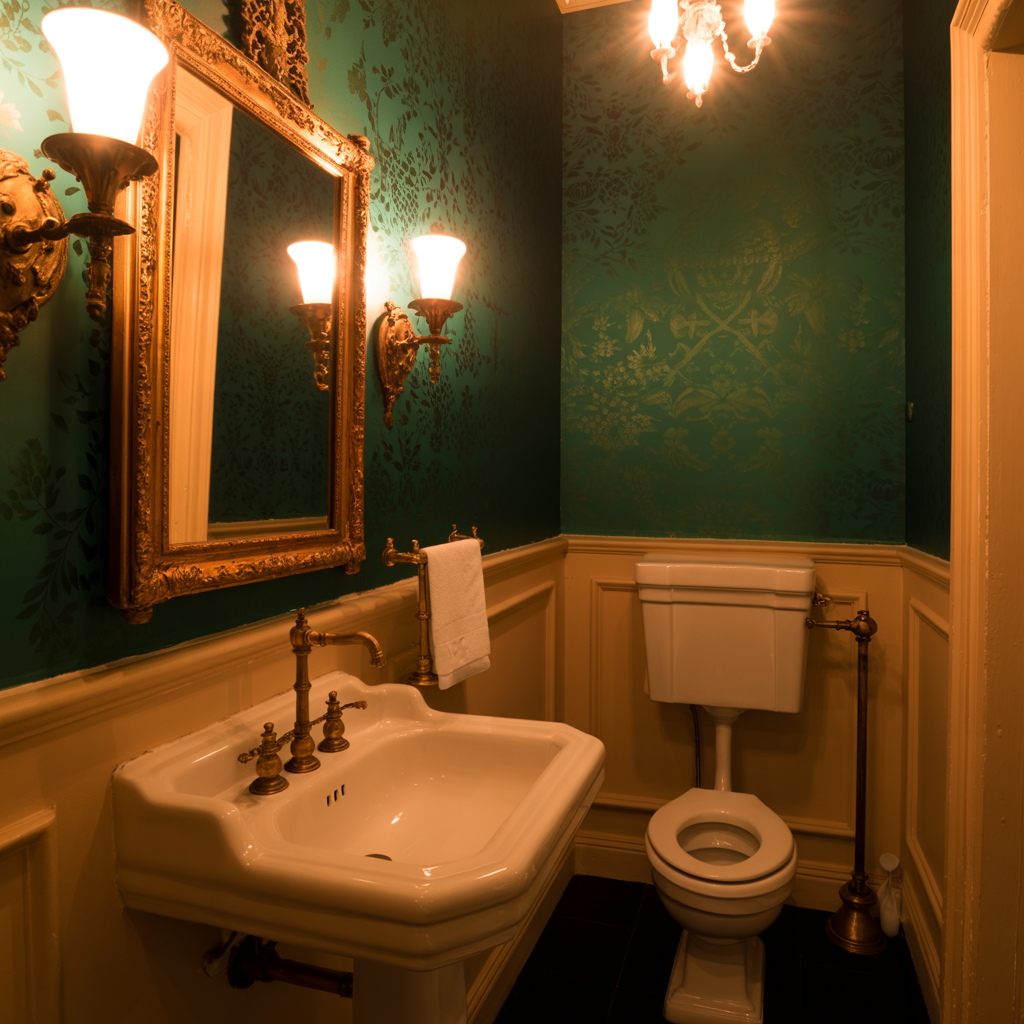
Lighting in Victorian-inspired spaces should feel warm, intimate, and slightly theatrical. The harsh, bright lighting of modern bathrooms would have been completely foreign to Victorians, who relied on gas lamps and candles to create the kind of soft, atmospheric illumination that made their spaces feel magical and mysterious.
Wall-mounted sconces with frosted glass shades, pendant lights with ornate metalwork, or even a small chandelier can provide the kind of ambient lighting that makes your downstairs toilet feel like a private retreat. The key is choosing fixtures that feel substantial and decorative rather than purely functional. Victorian lighting was meant to be seen and admired, not hidden away.
Consider the color temperature of your bulbs as well. Warm, golden light enhances the rich colors and brass fixtures that characterize Victorian design, while cool, white light can make the space feel clinical and modern. Dimmer switches allow you to adjust the lighting for different times of day and different moods, giving you the flexibility to create the perfect atmosphere for any occasion.
6. Incorporate Geometric Floor Tiles for Visual Foundation
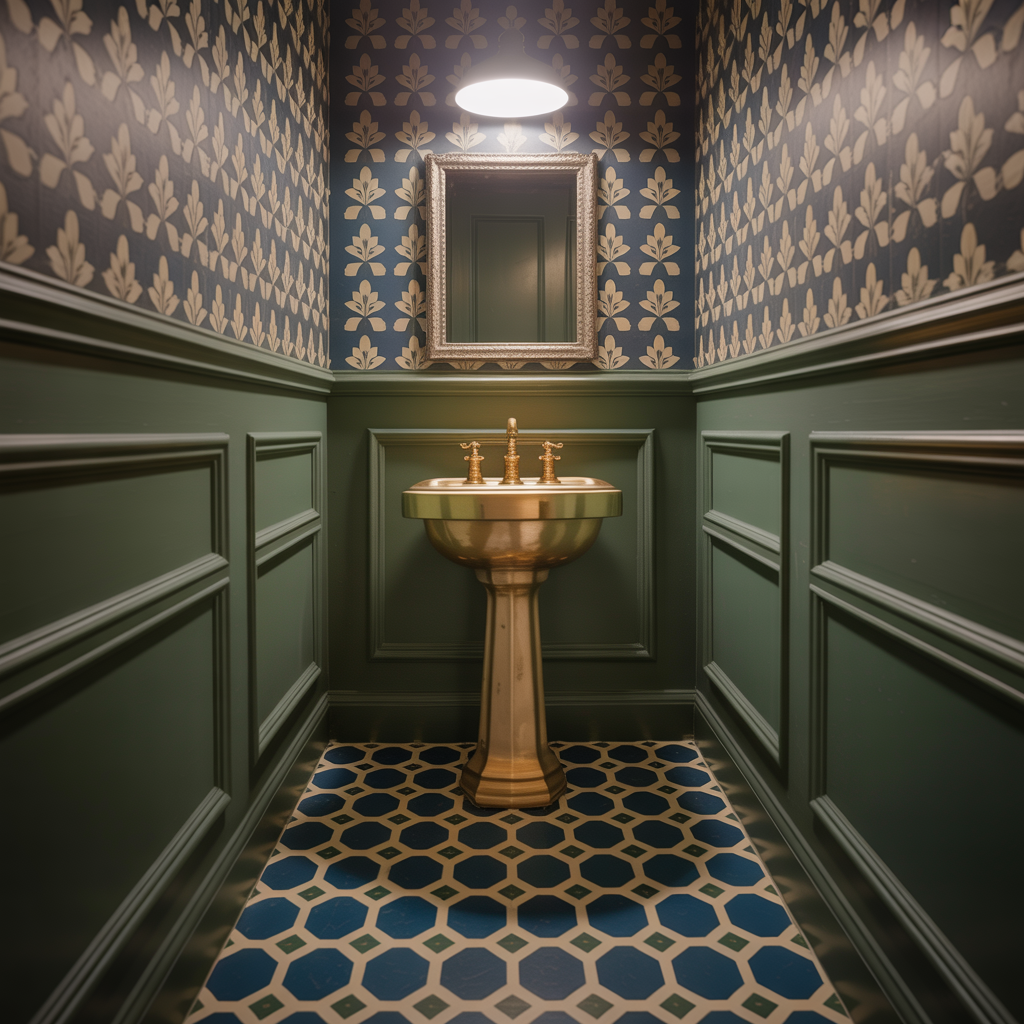
Victorian floor tiles were often masterpieces of geometric design intricate patterns in black and white, or rich combinations of deep blues, greens, and creams that created visual carpets of stunning complexity. These tiles weren’t just functional surfaces; they were decorative elements that anchored the entire room’s design scheme.
In a downstairs toilet, geometric floor tiles can make a dramatic impact without overwhelming the space. The key is choosing patterns that feel appropriately scaled for your room’s dimensions. Smaller geometric patterns work well in truly compact spaces, while larger, bolder patterns can handle slightly more generous dimensions. The contrast between geometric precision and organic wallpaper patterns creates the kind of visual tension that makes Victorian design so compelling.
Quality matters enormously with Victorian-inspired tiles. Look for tiles that have the weight and finish of period pieces porcelain or ceramic tiles with genuine depth of colour and crisp pattern definition. These tiles should feel substantial underfoot and provide the kind of durable, beautiful surface that will maintain its appearance for decades to come.
7. Install Traditional Sanitary ware with Period Details
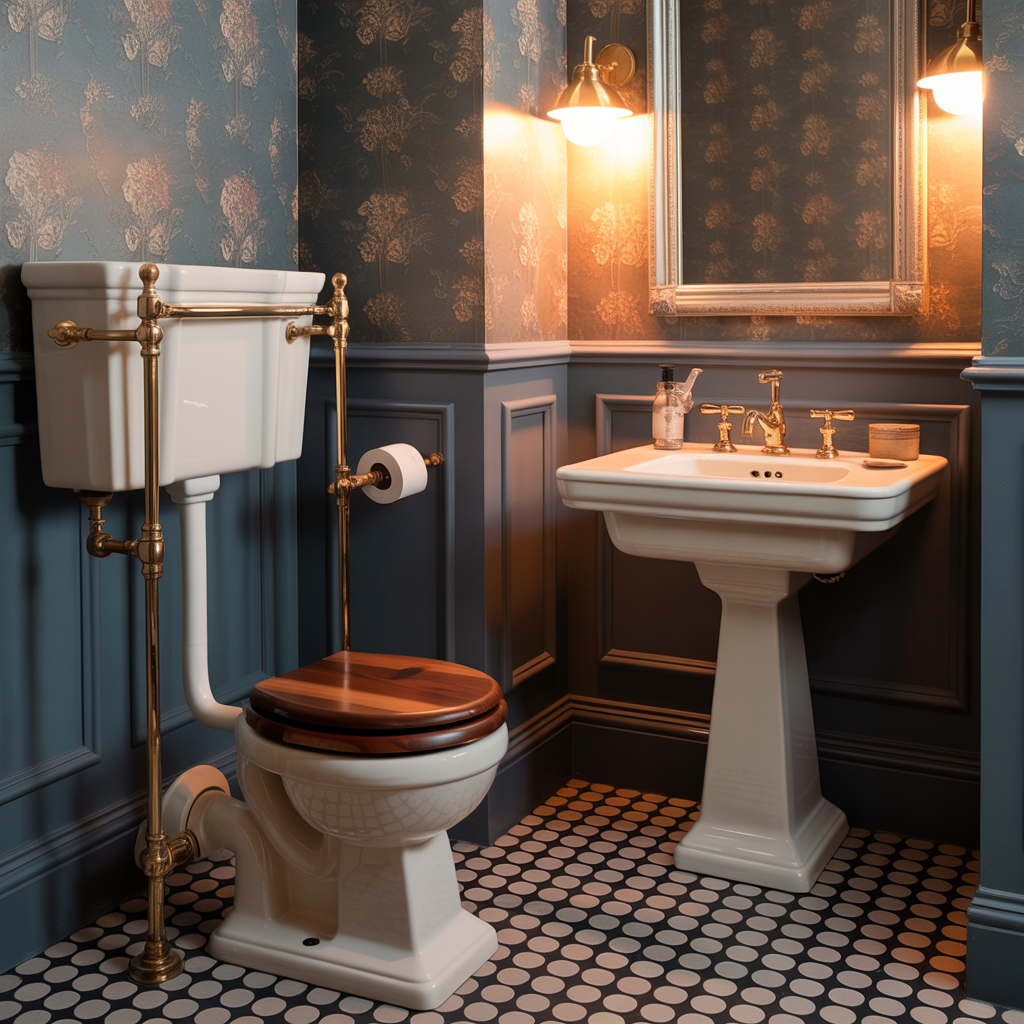
The toilet and basin are the functional heart of your downstairs toilet, and choosing pieces with authentic Victorian character makes an enormous difference in the overall success of your design. Traditional high-level cisterns with chain pulls, pedestal basins with separate hot and cold taps, and toilets with wooden seats create the kind of period authenticity that transforms a modern convenience into a Victorian experience.
What makes traditional sanitaryware so effective is how it combines historical accuracy with practical functionality. Modern reproductions of Victorian pieces offer the best of both worlds – they look authentically period while incorporating contemporary improvements in efficiency and hygiene. The visual impact of a high-level cistern with decorative brackets and ceramic pull, or a pedestal basin with ornate tap handles, immediately establishes the room’s Victorian character.
Consider the proportions of your chosen pieces carefully. Victorian sanitaryware was often more generous in scale than modern pieces, so look for basins and toilets that feel substantial rather than minimalist. The goal is creating a sense of Victorian grandeur even in a compact space, and appropriately scaled fixtures are essential to achieving this effect.
8. Maximize Impact with Ornate Mirrors and Reflective Surfaces
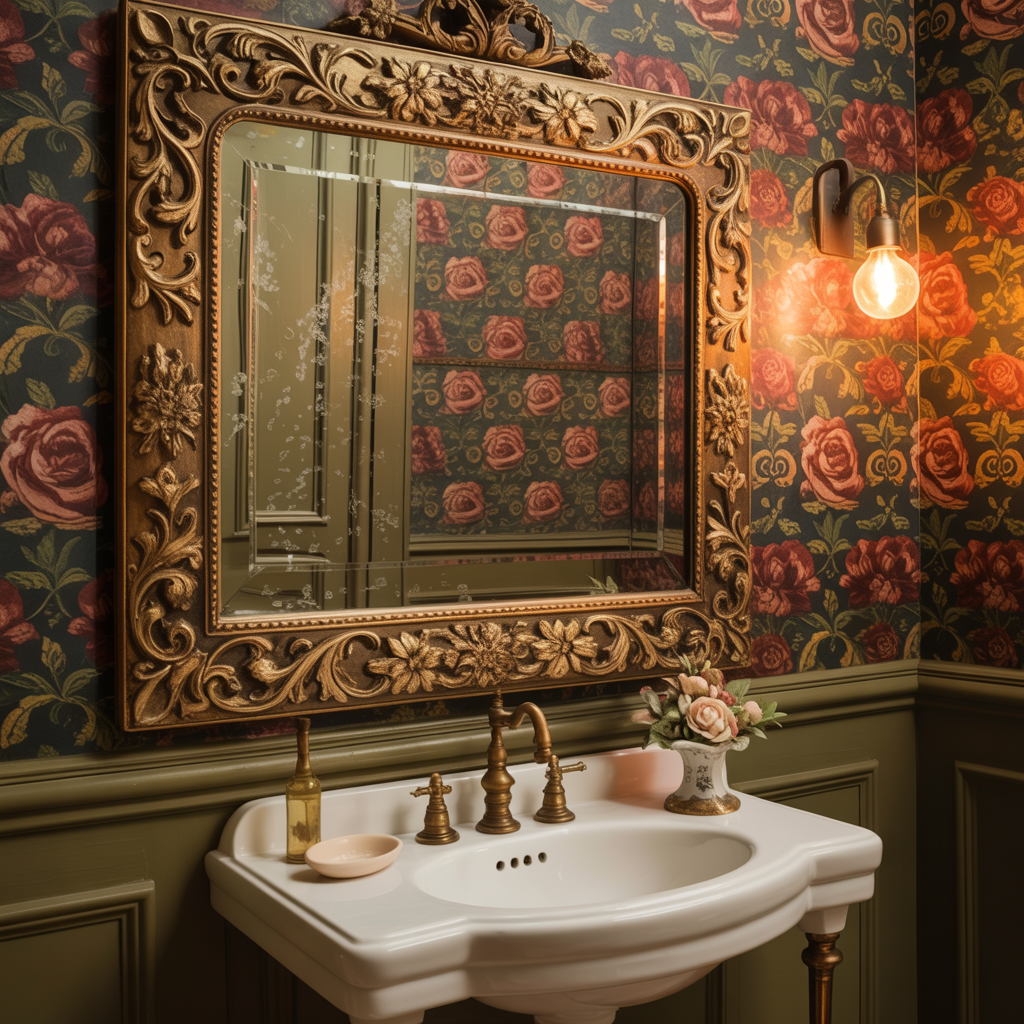
Mirrors in Victorian spaces were often decorative masterpieces in their own right – ornate frames in gilt or carved wood that served as focal points while serving practical needs. In a downstairs toilet, a well-chosen mirror can make the space feel larger while adding the kind of decorative detail that characterizes Victorian design.
The key is choosing mirrors that feel substantial and decorative rather than purely functional. Look for pieces with ornate frames, interesting shapes, or decorative etching that adds visual interest. Antique mirrors with slightly silvered glass can add authentic character, while reproduction pieces offer the Victorian look with modern clarity and durability.
Consider the placement of your mirror strategically. Positioned to reflect your decorative lighting or beautiful wallpaper, a mirror can multiply the visual impact of your other design elements. The goal is creating a sense of depth and visual complexity that makes your small space feel rich and layered rather than cramped or simple.
9. Solve Space Challenges with Vertical Design Elements
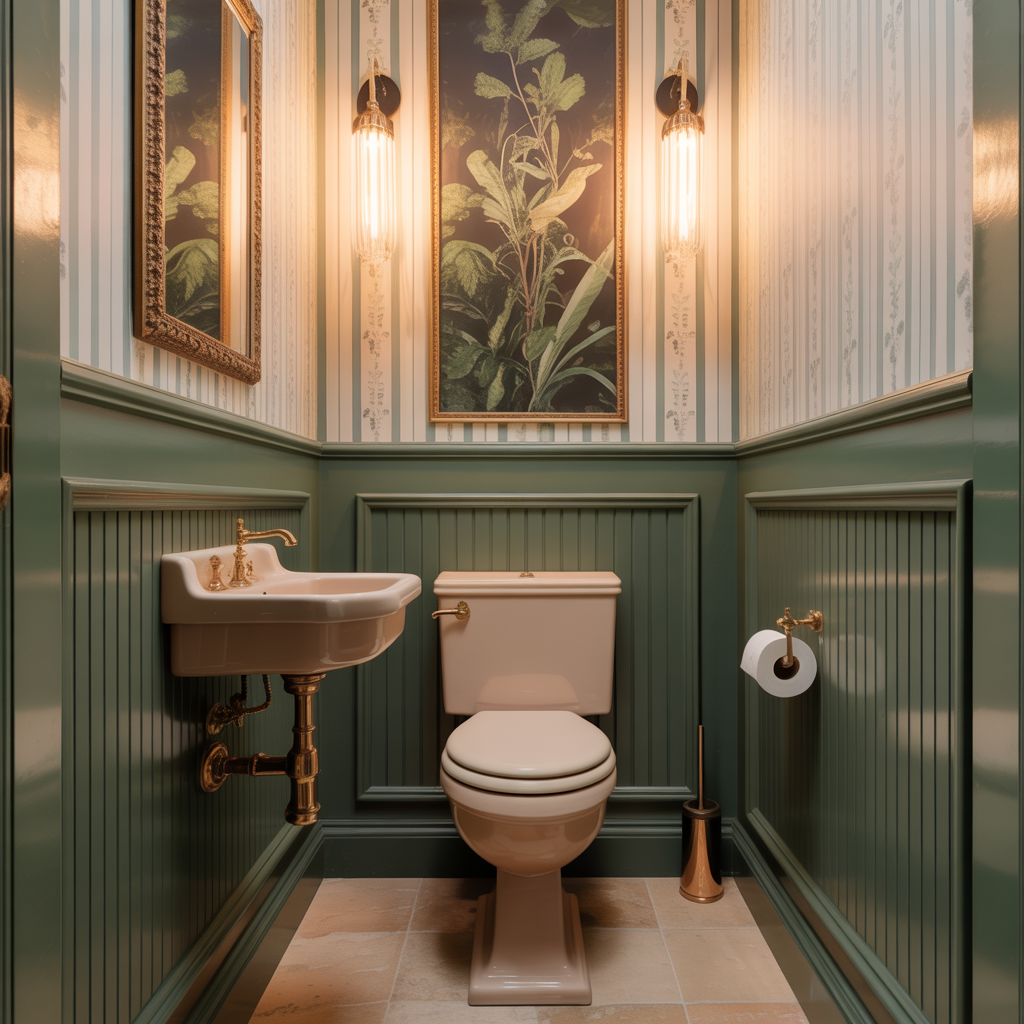
Victorian design principles can actually help solve the common challenge of making small spaces feel larger and more gracious. The key is using vertical elements tall wainscoting, vertically oriented wallpaper patterns, and fixtures that draw the eye upward to create the illusion of height and grandeur even in compact dimensions.
Vertical design elements work particularly well in downstairs toilets because they make the most of limited floor space while creating visual interest. Tall wainscoting that extends higher than the traditional chair rail height can make ceilings appear taller, while vertically striped wallpaper or patterns with strong vertical elements create the same effect. Wall-mounted fixtures and tall, narrow storage solutions keep the floor clear while maximizing functionality.
The Victorian approach to small spaces was to embrace their intimacy rather than fight against it. By using rich colours, ornate details, and vertical elements strategically, you can create a downstairs toilet that feels like a jewel box small but perfectly formed, intimate but not cramped, cozy but not claustrophobic.
10. Add Budget-Friendly Victorian Touches for Maximum Impact
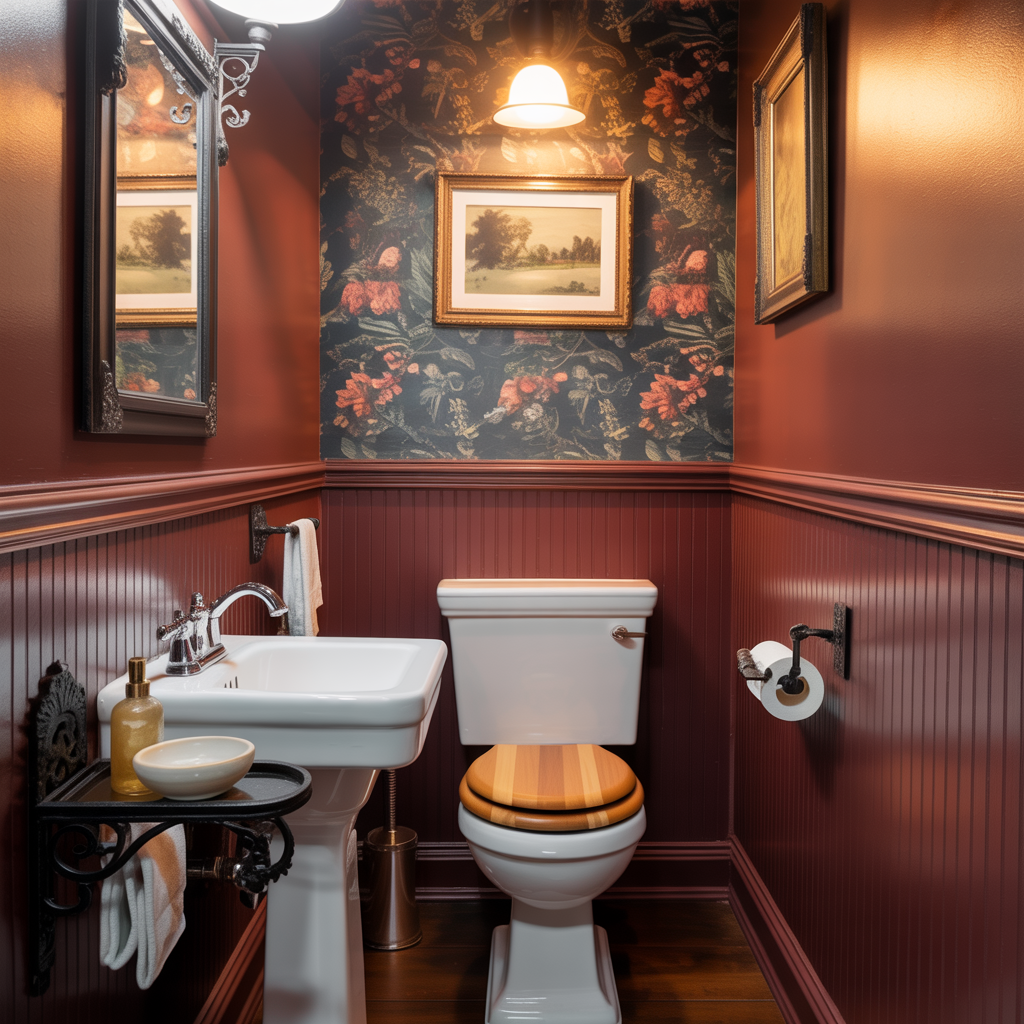
Creating authentic Victorian character doesn’t require unlimited resources it requires strategic thinking about where to invest for maximum impact. Some of the most effective Victorian touches are also the most affordable, proving that style and historical accuracy don’t always come with premium price tags.
Reproduction hardware offers one of the best opportunities for budget-friendly Victorian authenticity. Ceramic handle-pull chains, ornate towel hooks, and decorative brackets can be found at reasonable prices while providing the kind of period-appropriate details that make a real difference. Similarly, traditional paint colors in deep Victorian hues cost no more than modern alternatives while creating dramatically different atmospheric effects.
Wallpaper remains one of the most cost-effective ways to create Victorian drama. A single roll can transform a downstairs toilet, providing the kind of pattern and color that immediately establishes period character. Vintage-inspired accessories – soap dishes, towel holders, decorative containers – can often be found at antique shops or reproduction retailers for much less than modern designer alternatives while offering far more character and authenticity.
Creating Your Victorian Sanctuary
The magic of a well-designed Victorian downstairs toilet lies in its ability to transport guests into a different era while serving contemporary needs seamlessly. By focusing on the elements that truly matter – rich colors, authentic materials, period-appropriate fixtures, and attention to decorative detail – you can create a space that feels both historically accurate and thoroughly livable.
Remember that Victorian design was fundamentally about creating beauty in every aspect of daily life. The Victorians understood that even the most utilitarian spaces deserved thoughtful design, quality materials, and decorative elements that elevated everyday experiences. This philosophy remains as relevant today as it was 150 years ago.
The key to successful Victorian design is balance. Too many period elements can create a space that feels like a museum exhibit, while too few fail to capture the distinctive character that makes Victorian design so appealing. Aim for a harmonious blend of authentic elements and modern practicality that creates atmosphere without sacrificing functionality.
Your downstairs toilet may be small, but it has the potential to be one of the most memorable spaces in your home. By embracing Victorian principles of rich colour, ornate detail, and quality craftsmanship, you can create a powder room that surprises and delights every guest while reflecting your own appreciation for historical beauty and timeless design.

Add a Comment